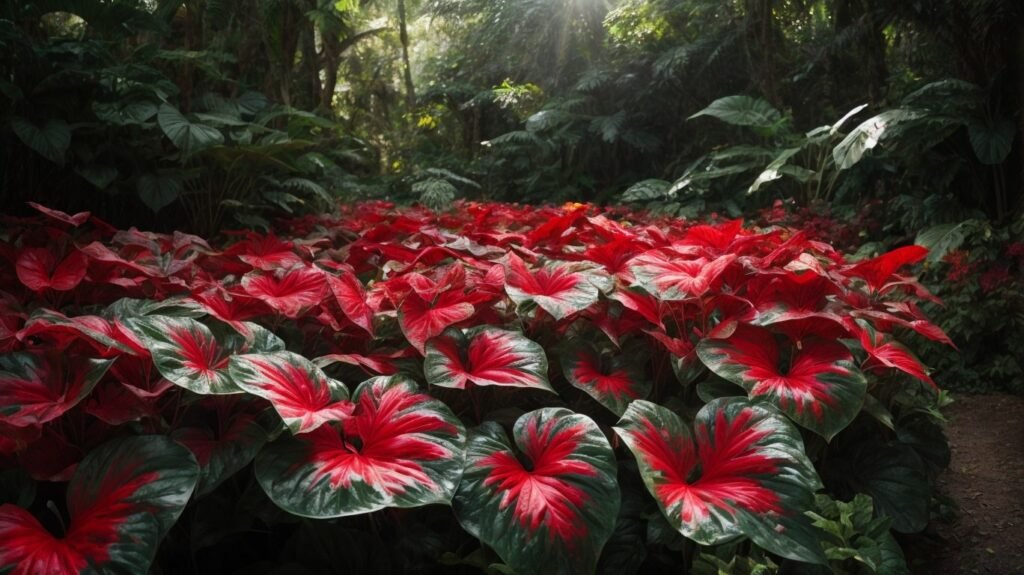Caladiums, also known as elephant ears, are tropical plants known for their large, heart-shaped leaves and vibrant colors. These plants are popular for their ornamental value and can be grown both indoors and outdoors. However, to ensure their optimal growth and health, it is crucial to provide them with the right type of soil.
Caladiums prefer a well-draining, rich soil that is slightly acidic in nature. This allows them to absorb essential nutrients and moisture while avoiding waterlogged conditions that can lead to root rot. The best soil for caladiums should have specific characteristics to support their growth and development.
- Well-Draining: The soil should have good drainage to prevent water from accumulating and causing root rot.
- Rich in Organic Matter: Caladiums thrive in soil that is rich in organic matter, providing essential nutrients for their growth.
- Slightly Acidic pH: A pH range of 6.0-6.5 is ideal for caladiums, as it enables them to absorb necessary minerals from the soil.
Some common soil mixes for caladiums include peat-based, pine bark-based, and compost-based mixes. These mixes provide the right balance of drainage, nutrients, and acidity for optimal growth.
To prepare the best soil for caladiums, start by choosing the right soil mix for your specific location and climate. Add a slow-release fertilizer, mix in additional organic matter such as compost or peat moss, and test the soil pH to ensure it is within the ideal range.
To maintain the best soil for caladiums, water regularly to keep the soil moist but not waterlogged. Mulch can also be used to retain moisture in the soil. Occasional fertilization can also help replenish essential nutrients, and monitoring soil pH can help ensure the soil remains slightly acidic. With the right soil and proper care, your caladiums will thrive and add beauty to your garden or home.
Key Takeaways:
- The best soil for caladiums should be well-draining, rich in organic matter, and have a slightly acidic pH.
- Common soil mixes for caladiums include peat-based, pine bark-based, and compost-based mixes.
- To prepare the best soil for caladiums, choose the right soil mix, add fertilizer, mix in additional organic matter, and test soil pH regularly.
What Are Caladiums?
Caladiums are tropical plants known for their vibrant, colorful foliage. They are popular for their large, heart-shaped leaves that come in various shades of green, pink, red, and white. Caladiums thrive in warm and humid environments, making them ideal for both indoor and outdoor gardens. These plants are typically grown from tubers and require well-draining soil and regular watering. They can be used to add a pop of color to garden beds, borders, or containers. Fun fact: Caladium leaves can grow up to 18 inches long, creating a stunning display in any garden setting.
What Type of Soil Do Caladiums Prefer?
Caladiums prefer well-draining soil that is rich in organic matter. They thrive in slightly acidic soil with a pH level between 5.5 and 6.5. To create a suitable soil mix for caladiums, combine equal parts of peat moss, perlite, and loamy soil. This combination provides the perfect balance of moisture retention and drainage. It is important to avoid heavy clay or compacted soil, as this can lead to root rot.
Additionally, caladiums benefit from a layer of mulch on top of the soil to help maintain moisture and regulate temperature. Interestingly, during the 19th century, caladiums gained popularity as a decorative plant, especially among Victorian gardeners. Their vibrant foliage and ability to thrive in shade made them a fashionable choice for gardens and indoor spaces. Even today, caladiums are adored for their striking colors and dramatic presence in landscapes and interiors.
What Are the Characteristics of the Best Soil for Caladiums?
When it comes to growing healthy and vibrant caladium plants, soil plays a crucial role. The best soil for caladiums should possess specific characteristics to support their growth and development. In this section, we will discuss the key qualities that make up the ideal soil for caladiums, including its ability to drain well, its richness in organic matter, and its slightly acidic pH. By understanding these characteristics, you can ensure that your caladiums thrive in their environment.
1. Well-Draining
Proper drainage is essential for the successful growth of caladiums. Follow these steps to ensure well-draining soil:
- Choose a soil mix specifically designed for container gardening.
- Improve drainage by adding perlite or coarse sand to the soil.
- Avoid compacting the soil by not over-watering or stepping on it.
- Make sure the pot or container has drainage holes to allow excess water to escape.
- Elevate the container slightly to prevent water from pooling at the bottom.
2. Rich in Organic Matter
Organic matter is crucial for creating the best soil for caladiums. To ensure that your soil is rich in organic matter, follow these steps:
- Begin with a base soil mix, such as peat or pine bark.
- Incorporate compost to increase the organic content.
- Add well-decomposed manure to boost nutrient levels.
- Consider including leaf mold or coconut coir for additional organic matter.
By following these steps, you can create a soil mix that is rich in organic matter, providing the necessary nutrients for healthy caladium growth. Remember to regularly amend the soil and maintain proper moisture levels for optimal results.
3. Slightly Acidic pH
To ensure the best soil for caladiums, it is crucial to maintain a slightly acidic pH level. Here are the steps to achieve this:
- Use a soil testing kit to determine the soil’s pH level. The ideal range for caladiums is between 5.5 and 6.5.
- If the pH is too high (alkaline), lower it by adding elemental sulfur or aluminum sulfate to the soil.
- Follow the instructions carefully and apply the recommended amount of sulfur or aluminum sulfate based on your soil test results.
- Thoroughly mix the amendment into the soil to ensure even distribution and allow it to react with the soil over time.
Maintaining a slightly acidic pH level will create the perfect growing conditions for caladiums, promoting healthy growth and vibrant foliage.
Remember to regularly monitor the pH level and make adjustments as needed to provide the best environment for your caladiums.
What Are Some Common Soil Mixes for Caladiums?
When it comes to growing caladiums, selecting the right soil is crucial for their health and growth. There are various soil mixes available, each with its own unique properties and benefits. In this section, we will discuss the most common soil mixes used for caladiums, including peat-based, pine bark-based, and compost-based mixes. By understanding the differences between these mixes, you can choose the one that best suits your gardening needs and ensures the success of your caladiums.
1. Peat-based Mix
A peat-based mix is a popular choice for caladiums due to its excellent water retention and nutrient-holding capacity. Follow these steps to create the best peat-based soil mix for caladiums:
- Begin by selecting high-quality peat moss as the base of the mix.
- Incorporate perlite or vermiculite to improve drainage and aeration.
- Add organic matter like compost or well-rotted manure to enhance nutrient levels.
- Include a slow-release fertilizer to provide sustained nutrition throughout the growing season.
By following these steps, you can create a well-balanced and nutrient-rich peat-based mix that will promote healthy growth and vibrant foliage in caladiums. Remember to water regularly, mulch to retain moisture, and monitor soil pH for optimal results.
2. Pine Bark-based Mix
A pine bark-based mix can be an excellent choice when preparing soil for caladiums. Here are the steps to create this mix:
- Start with high-quality potting soil as the base.
- Add a generous amount of pine bark fines for improved drainage.
- Incorporate perlite or coarse sand to further enhance drainage.
- Mix in a slow-release fertilizer to provide essential nutrients over time.
- Ensure the pH of the mix is slightly acidic, around 5.5 to 6.5.
By following these steps, you can create a pine bark-based mix that is perfect for caladiums, promoting healthy growth and vibrant foliage.
3. Compost-based Mix
A compost-based mix is a fantastic choice for cultivating caladiums, thanks to its nutrient-rich composition. To prepare a compost-based mix for caladiums, follow these steps:
- Begin with a base of high-quality compost, which serves as the main source of nutrients for the plants.
- Add equal parts of peat moss and perlite to the compost to improve drainage and aeration.
- Incorporate a slow-release fertilizer to provide a consistent supply of nutrients throughout the growing season.
- Consider adding well-rotted manure or worm castings to further enrich the soil’s fertility.
By following these steps, you can create a compost-based mix that will promote healthy growth and vibrant foliage in your caladium plants.
How to Prepare the Best Soil for Caladiums?
Proper soil preparation is crucial for the successful growth of caladiums. In this section, we will discuss the steps to create the best soil for these vibrant and tropical plants. We will cover the importance of choosing the right soil mix, adding fertilizer, and incorporating additional organic matter. Additionally, we will explore the significance of testing the soil’s pH level and how it can impact the overall health of your caladiums. So, let’s get our hands dirty and learn how to prepare the best soil for these stunning plants.
1. Choose the Right Soil Mix
Choosing the perfect soil mix is essential for the successful growth of caladiums. Follow these steps to find the right one:
- Evaluate the growing conditions and needs of your caladiums.
- Select a well-draining soil mix to prevent waterlogged roots.
- Ensure the soil mix is rich in organic matter to provide nutrients and improve moisture retention.
- Consider using a slightly acidic soil mix with a pH of 5.5 to 6.5, which is preferred by caladiums.
Fun Fact: Caladiums are originally from South America and were first cultivated by the indigenous people of the Amazon region.
2. Add Fertilizer
Adding fertilizer is an essential step in preparing the best soil for caladiums. Here are the steps to follow:
- Choose a balanced fertilizer, such as a 10-10-10 or 14-14-14, to provide a mix of essential nutrients.
- Follow the package instructions to apply the fertilizer, being careful not to over-fertilize and potentially burn the plant.
- Evenly spread the fertilizer around the base of the caladium plant, making sure to avoid direct contact with the leaves.
- Using a hand trowel or rake, gently work the fertilizer into the soil to ensure it is incorporated into the root zone.
- After applying the fertilizer, water the soil thoroughly to activate the nutrients and prevent any potential burning.
By following these steps and regularly fertilizing your caladiums, you can help promote healthy growth and vibrant foliage.
3. Mix in Additional Organic Matter
To improve the quality of soil for caladiums, follow these steps to incorporate additional organic matter:
- Begin with a well-draining soil mix to prevent waterlogging.
- Add compost or well-rotted manure to enhance soil fertility and structure.
- Incorporate organic matter, such as leaf mold or peat moss, to increase moisture retention.
- Mix in organic fertilizers, like composted chicken manure or worm castings, to enrich the soil with nutrients.
By following these steps, you can ensure that your caladiums have a nutrient-rich and well-balanced soil environment, promoting their growth and overall health.
4. Test Soil pH
To ensure the best soil for caladiums, it is important to test the soil pH. Here are the steps to properly test and adjust the pH:
- Purchase a soil pH testing kit from a garden center.
- Collect a soil sample from the area where you plan to plant your caladiums.
- Follow the instructions on the kit to test the soil pH.
- If the pH is not within the ideal range (typically between 5.5 and 6.5 for caladiums), make the necessary adjustments.
- To lower the pH, you can add elemental sulfur or acidic organic matter such as peat moss.
- To raise the pH, you can add lime or alkaline organic matter like crushed eggshells.
By testing and adjusting the soil pH, you can create the perfect growing environment for your caladiums.
What Are Some Tips for Maintaining the Best Soil for Caladiums?
For caladiums to thrive, it is crucial to provide them with the best soil conditions. In this section, we will discuss helpful tips for maintaining the ideal soil for your caladiums. From proper watering techniques to monitoring soil pH levels, we’ll cover everything you need to know to keep your caladiums healthy and vibrant. So let’s get started and ensure your caladiums have the best soil for optimal growth.
1. Water Regularly
To promote healthy growth and vibrant foliage, it is crucial to water caladiums regularly. Here are the steps to follow:
- Check soil moisture: Before watering, check the soil moisture by inserting a finger into the soil up to the first knuckle. If the soil feels dry, it’s time to water.
- Water deeply: Thoroughly water the caladiums, making sure to reach the root zone. Ensure that the water penetrates deeply into the soil.
- Consider the climate: In hot and dry climates, caladiums may require more frequent watering. Keep an eye on the weather conditions and adjust watering accordingly.
- Avoid overwatering: While caladiums appreciate regular watering, be careful not to overwater. Too much moisture can lead to root rot.
By following these steps and maintaining a consistent watering routine, you can provide the optimal moisture levels for your caladiums to thrive.
2. Mulch to Retain Moisture
To promote healthy growth and retain moisture for caladiums, it is important to mulch effectively. Follow these steps to mulch properly:
- Clear the area around the caladium plants.
- Spread a layer of organic mulch, such as straw or wood chips, around the base of the plants.
- Make sure the mulch layer is around 2-3 inches thick.
- Avoid piling the mulch directly against the stems to prevent rot.
Pro-tip: Remember to periodically replenish the mulch layer to maintain moisture levels and suppress weed growth.
3. Fertilize Occasionally
To maintain optimal soil conditions for caladiums, it is important to fertilize occasionally to provide necessary nutrients. Follow these steps to properly fertilize your caladiums:
- Choose a balanced, slow-release fertilizer specifically formulated for caladiums.
- Apply the fertilizer according to the package instructions, typically every 4-6 weeks during the growing season.
- After fertilizing, thoroughly water the soil to ensure proper absorption.
- Avoid over-fertilizing, as it can result in leaf burn and damage to the plants.
Fact: Over-fertilizing can cause leaf burn and decrease the overall health of caladium plants.
4. Monitor Soil pH
To ensure the best soil for caladiums, it is important to regularly monitor the soil pH. Follow these steps to effectively monitor and adjust the soil pH for caladiums:
- Obtain a soil pH testing kit from a gardening store.
- Collect soil samples from various areas of the caladium planting bed.
- Use the instructions provided with the pH testing kit to test the soil samples.
- Compare the results with the recommended pH range for caladiums, which is slightly acidic (around 5.5 to 6.5).
- If the pH is too high, add amendments such as sulfur or peat moss to lower it.
- If the pH is too low, add lime or wood ash to raise it.
- Periodically retest the soil to ensure that the pH remains within the desired range.
By carefully monitoring and adjusting the soil pH, you can provide the optimal growing conditions for your caladium plants.
Frequently Asked Questions
What is the best soil for Caladiums?
The best soil for Caladiums is a well-draining, slightly acidic substrate with good water permeability. The ideal pH range is between 5.5 and 6.5. Conventional potting soils are not recommended, and a special mixture or homemade substrate is preferred
What are the humidity requirements for Caladiums?
Caladiums prefer humidity levels of around 50-60%, as high humidity helps prevent crispy leaf tips. However, they can tolerate various levels of humidity, but higher levels are preferred to mimic their native tropical environment.
Do Caladiums have flat leaves like elephant ears?
Yes, Caladiums have flat and broad leaves, resembling elephant ears. These leaves come in different colors and patterns, making them a unique and beautiful houseplant to add to any indoor or garden display
How often should I water Caladiums?
Caladiums prefer slightly moist soil and do not tolerate being in soggy soil or completely dry soil. Finding a balance between overwatering and underwatering is important for their growth and health. Watering once or twice a week is generally recommended, but always check the soil moisture level before watering.
Can I use coconut fiber chips in my caladium soil mix?
Yes, adding coconut fiber chips to the soil mix for Caladiums is optional. These chips can help improve water retention and provide extra nutrients for the plant. However, they should not make up a large portion of the mix as they can hold onto too much moisture and lead to root rot.
Do Caladiums require a special fertilizer?
Caladiums do not require a special fertilizer, but a balanced, diluted liquid fertilizer can be applied once or twice a month during the growing season to promote healthy growth and vibrant leaves. A standard houseplant fertilizer with a ratio of 20-20-20 or 10-10-10 is suitable for Caladiums.



